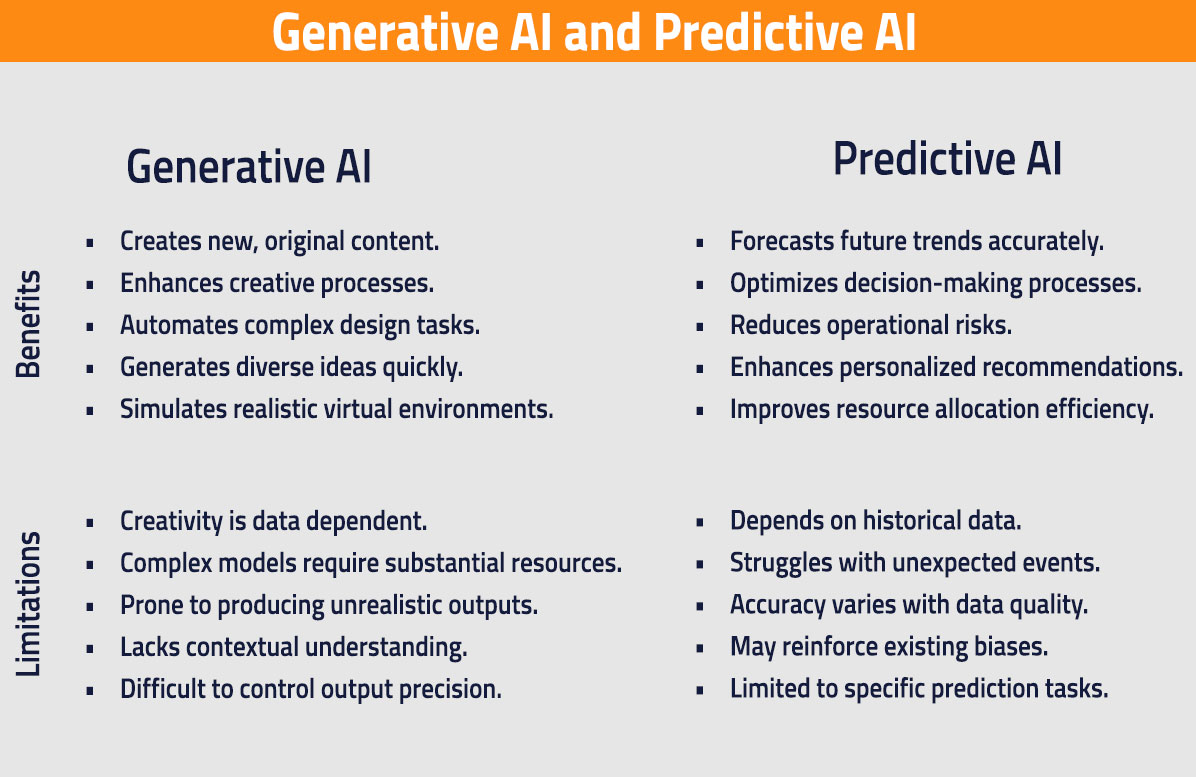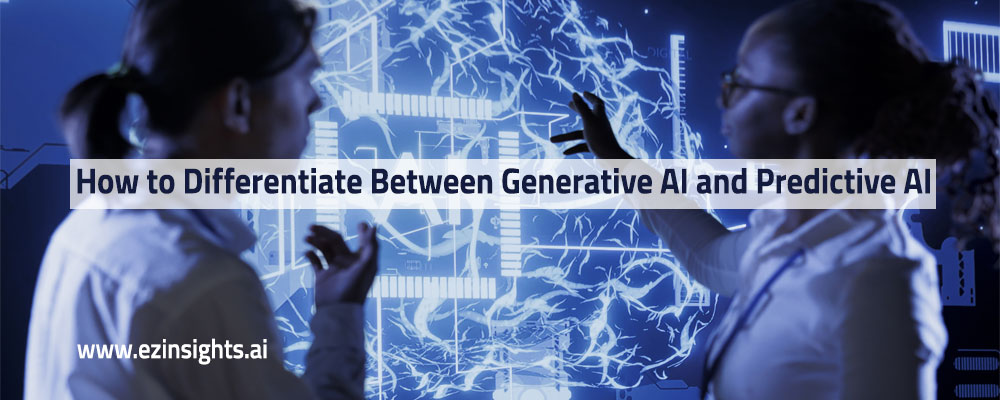Artificial intelligence (AI) is redefining industries, accelerating innovation, and changing the way people interact with technology. Among the different fields of AI, Generative AI and Predictive AI are two important techniques with distinct capabilities and applications. Understanding the distinction between these two types of AI is critical for firms wishing to properly use them. In this blog, we’ll look at the fundamental differences between Generative AI and Predictive AI, including definitions, applications, and predictive modeling procedures.
Generative AI vs. Predictive AI: An Overview
Generative AI and Predictive AI are two types of artificial intelligence that serve distinct functions and are applied in a variety of scenarios. To understand their differences, let’s look at their definitions and applications in depth.
Generative AI Definition
Generative AI refers to algorithms that generate fresh data that is like the data used to train them. These models create new information, such as photos, text, or audio, that is like the original data’s style and structure. Generative AI is primarily concerned with creating innovative outputs based on patterns discovered in existing data.
Key Features of Generative AI Models:
- Content Creation: Generative AI can create text, graphics, and music. For example, a Generative AI model trained on numerous artworks can produce new, one-of-a-kind works of art.
- Creative Applications: Generative AI is used in art, entertainment, and design to assist artists and designers by providing new concepts and ideas.
- Synthetic Data Generation: It may also generate synthetic data to train other models or test them, which is especially valuable when real data is limited or sensitive.
Predictive AI Definition
In contrast, predictive AI makes predictions about future occurrences or behaviors based on historical data. Predictive models evaluate historical data trends to estimate future events, which can aid in decision-making and strategic planning.
Key Features of Predictive Modeling
- Forecasting: Predictive models are used to estimate future patterns in sales, customer behavior, and stock market movements.
- Decision Support: Predictive analytics is used by businesses to help them make decisions such as optimizing marketing tactics or managing inventory.
- Risk Management: By anticipating future risks and issues, companies can take proactive steps to mitigate them.
Generative AI Models vs. Predictive Models
The primary distinction between Generative AI and Predictive AI is their objectives and outcomes. Let us break this down further:
Generative AI Models
Generative AI models, like Generative Adversarial Networks (GANs) and Variational Autoencoders (VAEs), are intended to create new content. These models learn from current data and then generate new data that is like it.
GANs: GANs are made up of two networks: a generator and a discriminator, which compete to produce realistic data. The generator generates fresh data, and the discriminator assesses it, resulting in increasingly better-generated outputs.
VAEs: VAEs encode input data into a latent space, which is subsequently decoded to generate new data. This approach enables the production of data with variations depending on previously learnt latent representations.
Predictive Model Selection
- Predictive models use historical data to forecast future events. Choosing the appropriate predictive model requires multiple steps:
- Define the Problem: Determine the type of prediction needed (e.g., classification or regression).
- Data Collection: Collect relevant historical data for training and testing the model.
- Feature Selection: Determine the variables (features) that are most relevant to the prediction task.
- Model Training: Select a good predictive modeling technique, such as linear regression, decision trees, or neural networks, and train the model with historical data.
- Model Evaluation: Evaluate the model’s performance using measures like accuracy, precision, recall, and mean squared error.
- Deployment: Use the model in a real-world environment to make predictions and inform decisions.
Predictive Modeling Process
- The predictive modeling technique is a systematic approach to creating models that can forecast future outcomes using historical data. This method consists of several essential stages:
- Problem Definition: Clearly explain the prediction task and the intended results. Understanding the business problem is critical for picking an acceptable model.
- Data Preparation: Clean and preprocess the data to ensure that it is ready for analysis. These covers dealing with missing values, standardizing data, and encoding categorical variables.
- Exploratory Data Analysis (EDA): Examine the data to better comprehend its structure, detect patterns, and discover links between variables.
- Model Building: Choose and develop the predictive model. This process consists of selecting a method, tweaking hyperparameters, and training the model.
- Validation and Testing: Use validation and testing datasets to evaluate the model’s performance. This ensures that the model can generalize adequately to new, previously unknown data.
- Deployment and Monitoring: Run the model in a production setting and track its performance over time. Regular upgrades and recalibrations may be required to ensure accuracy.
Applications of Generative AI and Predictive AI
Generative AI and Predictive AI have applications in a variety of domains:
Generative AI applications
Content Creation: Creating imaginative stuff such as art, music, and literature.
Healthcare: Generate synthetic medical data for study and training.
Entertainment: Create new characters, storylines, and experiences for games and films.
Predictive AI applications
Retail: forecasting sales trends and controlling inventory.
Finance: Forecasting stock prices, credit risk, and market trends.
Healthcare: Anticipating patient outcomes and optimizing treatment strategies.
Choosing Between Generative and Predictive AI
The choice between Generative AI and Predictive AI is based on your individual demands and objectives:

- If you need to develop new material or simulate data, Generative AI is the best option. It excels in producing novel results and improving creative processes.
- If you want to forecast future trends or use historical data to inform decision-making, Predictive AI is the superior solution. It focuses on examining past patterns to forecast future events and inform strategic decisions.
Conclusion
Understanding the distinction between Generative AI and Predictive AI is critical for efficiently applying these technologies. While Generative AI excels at creating new content and synthetic data, Predictive AI is effective at projecting future outcomes and assisting decision-making processes. Businesses can make educated decisions and fully realize the promise of AI to drive innovation and success by identifying their respective strengths and applications.
Whether you’re looking at Generative AI models for creative applications or implementing predictive modeling to optimize strategies, these AI approaches can help you achieve your goals. Embrace the potential of AI and transform your business by selecting the best approach for your requirements.
FAQs
What is the main difference between generative AI and predictive AI?
Generative AI generates new material or data based on patterns learned from existing data. For example, it can produce writing, photos, or music that resembles human-created stuff. In contrast, predictive AI forecasts future outcomes or trends based on historical data. Its major purpose is to estimate future events using past patterns, such as stock prices or customer behavior.
Can you provide examples of applications for generative AI and predictive AI?
Generative AI uses include making artwork, producing realistic text (e.g., chatbot responses), and synthesizing human-like voices. Examples include GPT-4 for text generation and DALL-E for image creation. Predictive AI uses include forecasting sales trends, diagnosing medical diseases based on symptoms, and recommending items based on user behavior. Examples include machine learning models for financial forecasting and e-commerce platform recommendation systems.
How do the underlying technologies of generative and predictive AI differ?
The underlying technologies of generative and predictive AI may overlap, but their implementations serve distinct functions. Generative AI frequently uses models such as Generative Adversarial Networks (GANs) or Variational Autoencoders (VAEs) to generate new content. To forecast based on previous data, predictive AI typically employs regression models, time series analysis, or classification algorithms. The model and approach used are determined by whether the goal is to generate fresh material or anticipate future events.
Are there any common challenges associated with generative and predictive AI?
Yes, both types of AI face different obstacles. Generative AI may struggle with difficulties such as the quality and diversity of created content, as well as ethical concerns concerning abuse. Predictive AI frequently faces issues such as data quality, model correctness, and the possibility of overfitting to past data. Both types of AI require rigorous control to deliver consistent and ethical results.

Anupama Desai
President & CEO
Anupama has more than 23 years of experience as business leader and as an advocate for improving the life of the business users. Anupama has been very active in bringing business perspective in the technology enabled world. Her passion is to leverage information and data insights for better business performance by empowering people within the organization. Currently, Anupama leads Winnovation to build world class Business Intelligence application platform and her aim is to provide data insights to each and every person within an organization at lowest possible cost.

